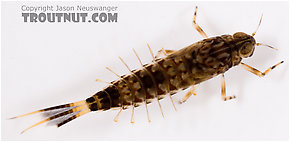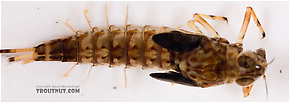Blog & Latest Updates
Fly Fishing Articles
Insects by Common Name


Mayfly Species Ameletus ludens (Brown Dun)
Taxonomic Navigation -?-
Kingdom
Animalia (Animals)
» Phylum
Arthropoda (Arthropods)
» Class
Insecta (Insects)
» Order
Ephemeroptera (Mayflies)
» Family
Ameletidae (Brown Duns)
» Genus
Ameletus (Brown Duns)
» Species ludens (Brown Dun)
Common Name
| Match | Common Name |
| Brown Dun |
Where & When
This is the most important Eastern species of Ameletus.
Hatching Behavior
Fred Arbona notes in Mayflies, the Angler, and the Trout that the best Ameletus ludens hatches come on cloudy days.
Pictures of 3 Mayfly Specimens in the Species Ameletus ludens:
Ameletus ludens (Brown Dun) Mayfly Nymph View 9 Pictures
View 9 Pictures
 View 9 Pictures
View 9 PicturesCollected March 29, 2005 from Salmon Creek in New York
Added to Troutnut.com by Troutnut on April 7, 2006
Added to Troutnut.com by Troutnut on April 7, 2006
Ameletus ludens (Brown Dun) Mayfly Nymph View 7 Pictures
View 7 Pictures
 View 7 Pictures
View 7 PicturesCollected April 1, 2007 from Mystery Creek #62 in New York
Added to Troutnut.com by Troutnut on April 3, 2007
Added to Troutnut.com by Troutnut on April 3, 2007
Ameletus ludens (Brown Dun) Mayfly Nymph View 6 Pictures
View 6 Pictures
 View 6 Pictures
View 6 PicturesCollected May 6, 2007 from Mongaup Creek in New York
Added to Troutnut.com by Troutnut on May 18, 2007
Added to Troutnut.com by Troutnut on May 18, 2007
Recent Discussions of Ameletus ludens
Brown Dun hatch/swarm time? 10 Replies »
Has anyone else watched a Brown Dun hatch or swarm? If so, what time of day did you see it, and how long did it last?
I came upon a woodland swarm late this evening. I thought I saw mating occurring higher above the stream. This would mean that parthenogenesis is not necessarily happening in "my" stream. I watched for awhile, but got distracted (venomous snake). I hope to catch it (the hatch, not the snake) again tomorrow night and note the egg-laying behavior and possibly nab some male adults for science. There's a range of nymph ages, so I should be OK, weather permitting.
ReplyI came upon a woodland swarm late this evening. I thought I saw mating occurring higher above the stream. This would mean that parthenogenesis is not necessarily happening in "my" stream. I watched for awhile, but got distracted (venomous snake). I hope to catch it (the hatch, not the snake) again tomorrow night and note the egg-laying behavior and possibly nab some male adults for science. There's a range of nymph ages, so I should be OK, weather permitting.
Your Thoughts On Ameletus ludens:
Top 10 Fly Hatches
Top Gift Shop Designs
Eat mayflies.
Top Insect Specimens
Miscellaneous Sites
Troutnut.com is copyright © 2004-2024 Jason
Neuswanger (email Jason). See my FAQ for information about use of my images.
 privacy policy
privacy policy
